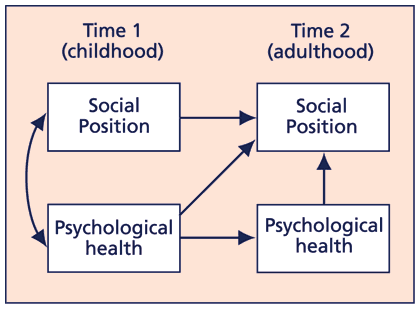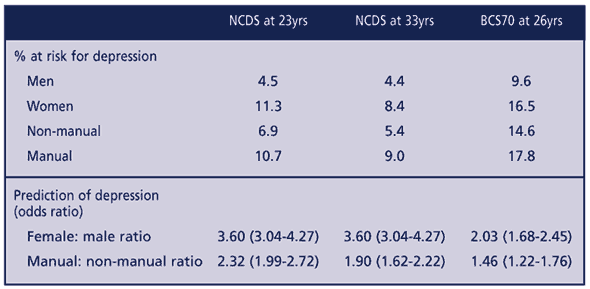 |
Close
window to return
|
Issue 4, July 1999, pp.8-10.
Childhood
influences on socio-economic inequalities in adult mental health: path
analysis as an aid to understanding
Amanda Sacker, Ingrid Schoon and Mel Bartley
Introduction
Tackling mental ill-health is a priority of the government's new public
health strategy. Between 5% and 20% of the adult population suffer from
depression. Nearly 1 in 5 children also exhibit psychological problems.
While there is a well-established socio-economic gradient in psychological
well-being among adults and children, less is known about the causal mechanisms
underlying this relationship.
An important line of enquiry has focused on the contribution of childhood
disadvantage to the socio-economic gradient in adult mental health. The
mechanisms are likely to be complex: with, for example, early experiences
of socio-economic disadvantage and psychological problems potentially
influencing both adult socio-economic status and adult mental health.
One way of teasing out these inter-related lifecourse influences is to
use path analysis. The advantage of the method is that theories must be
defined in advance and laid out in the form of path models, with the lines
of influence made clear. The path models can then be tested and the efficacy
of competing models evaluated in terms of how well they match the relationships
actually found in the data. This method will be illustrated using path
models based on two theories of why there are inequalities in adult mental
health: direct health selection and social causation. We show how examining
these two simple models enables us to pinpoint areas for future work.
Figure 1: Direct health selection model

The two theoretical
approaches to health inequalities in adulthood
Direct health selection(1) and social causation(2) are only two of the
explanations put forward to account for the persisting socio-economic
gradient in health. However, they provide a useful starting point for
illustrating the potential of path analysis in advancing understanding.
Figure 1 provides a path model for direct health selection. It argues
that psychological problems in childhood are causally related to poor
mental health in adulthood and to downward inter-generational social mobility
(and thus to social position in adulthood). In addition, psychological
health in adulthood contributes to intra-generational social mobility.
However, evidence in support of the link between psychological problems
in childhood and adult mental health and socio-economic position is limited.
A weak relationship between health in childhood and social class in adulthood
was reported using data from the 1946 birth cohort,(3) while Power and
Peckham (1990) found morbidity at age 7 predicted emotional health problems
in early adulthood in the 1958 cohort.(4)
The social causation theory would suggest that socio-economic circumstances
in childhood influence both socio-economic status and mental functioning
in adulthood. The direction of the relationship between socio-economic
status and health in adulthood is reversed from that suggested by direct
health selection theories, with socio-economic position in childhood and
adulthood affecting adult mental health (see Figure 2). Partial support
for this theory comes from evidence showing that social class at birth
predicts both social class and psychological distress in adulthood.5
Figure 2: Social causation model

Social class and
gender patterns
For this demonstration of path analysis, we use data from two British
cohorts: the 1958 National Child Development Study (NCDS) and the 1970
British Birth Cohort (BCS70). Two time points were used for analysis from
the BCS70 (ages 16 and 26 years) and three time points from the NCDS (at
16, 23 and 33 years). Measures of socio-economic position and mental well-being
were available for each time period. Data are taken for cohort members
who have been in employment and can therefore be classified by their own
social class in adulthood.
The figures in Table 1 show that depression is more common among women
than men and among individuals in manual work than among those in non-manual
occupations. Within the NCDS, the social gradient in mental health is
less steep for cohort members in their 30s than when they were in their
early 20s. The social gradient in mental health also appears to be weaker
in the BCS70 cohort than in the NCDS cohort.
Table 1: Proportion of cohort members at risk for depression by sex
and social class at different ages

The weakening of the socio-economic gradient may reflect the changing
impact of economic recession on those in manual and non-manual employment.
The economic recession which lasted from 1979 until 1986 resulted in a
dramatic loss of heavy manufacturing and textile occupations. The second
recession took place in the early 1990's and, while manual workers again
bore the brunt, job insecurity and unemployment also increased among those
in non-manual occupations.
Testing the models
The childhood origins of these social inequalities in adult mental health
were examined using path analysis. Three models were compared: a social
causation model, a direct health selection model and a combined model
which included both direct health selection and social causation theory.
First, the findings for the simpler models for BCS70 are summarised as
follows:
- neither direct health selection nor social causation are fully able to explain the relationship between social class and mental well-being at 26;
- both psychological problems and father's social class in adolescence increase the risk for mental health problems in early adulthood;
- achieved social position in early adulthood is also affected both by father's social class and psychological problems in adolescence;
- inter-generational social mobility is greater for women than for men;
- the continuation of behavioural problems in adolescence into mental health problems at 26 years is slightly stronger for men than women;
- there is still a significant unexplained relationship between social class at 26 and mental well-being at 26 after pathways from age 16 have been taken into account;
- approximately 50% of the relationship between social class and mental well-being at 26 years is accounted for by these pathways from adolescent behaviour and father's social class.
The combined model applied to the NCDS cohort is more complex since it involves three time periods. Of note are the following:
- neither direct health selection nor social causation fully explains the relationship between social class and mental well-being at 23 and at 33 years;
- both psychological problems and father's social class in adolescence increase the risk for mental health problems in early adulthood;
- achieved social position in early adulthood is also affected both by father's social class and psychological problems in adolescence;
- psychological problems at 16 affect occupational position not only early in cohort members' careers but also once careers are established;
- psychological problems at 16 increase the risk for mental health problems with onset early on and later in adulthood;
- father's social class during adolescence affects occupational position not only early in cohort members' careers but also has additional influence once careers are established;
- father's social class has a direct influence on mental well-being early in adulthood but only an indirect effect via social position on mental health later in life;
- inter-generational mobility is again greater for women than men;
- but, intra-generational mobility is similar for men and women;
- approximately 50% of the relationship between social class and mental well-being at 23 years is accounted for by pathways from both class and psychological problems at age 16;
- almost 100% of the relationship between social class and mental well-being at 33 years is accounted for by pathways from age 16.
Conclusions
The application of path analysis techniques to the NCDS and the BCS70
provides a demonstration of their potential for measuring the lifecourse
influences on adult health. While the results have been generated primarily
for illustrative purposes, they paint a similar picture in both cohort
studies. Both direct health selection and social causation appear to be
at work, with mental health affecting social position and social position
affecting health. Direct health selection and social causation explain
some, but not all of the social gradient in mental health in early adulthood.
In the NCDS and BCS70, 50% of the relationship between mental health and
social position in early adulthood (age 23 in the NCDS and 26 in the BCS70
cohort) is explained by adolescent experiences. By the age of 33, the
social gradient in mental health in the NCDS can be fully explained by
prior experiences, both in childhood and early adult life. We shall have
to wait for a further wave of data collection from the BCS70 cohort to
see whether this finding is replicated.
The challenge for the project is to unravel the processes by which socio-economic
position affects mental health and mental health affects socio-economic
position. For example, what is the role of educational achievement? Both
father's social class and childhood mental health have influences on education
which in turn has long lasting effects on occupational opportunities.
In this demonstration of path analysis, we have only considered he pathways
from adolescence to adulthood, but conditions earlier in childhood may
be setting children on developmental trajectories which mark their adult
lives. A further focus of this project is to ascertain whether the effects
of adverse social circumstances in childhood influence adult mental health
directly or whether it is only children who express their distress in
behavioural and educational problems who are at a disadvantage later in
life.
Amanda Sacker and Mel Bartley are based at the Department of Epidemiology
and Public Health, University College London Medical School.
Ingrid Schoon is based at the Department of Psychology, City University
References:
1. Stern, I. (1983) 'Social mobility and the interpretation of social
class mortality differentials' Journal of Social Policy, 12 pp.27-49
2. Davey Smith, G., Bartley, M. and Blane, D. (1990) 'The Black Report
on socio-economic inequalities in health 10 years on' .British Medical
Journal, 301(6748) pp.373-377
3. Wadsworth, M. E. J. (1986) 'Serious illness in childhood and its association
with later life achievement' in R. G. Wilkinson (ed.), Class and Health
pp.50-74 London : Tavistock. Institute.
4. Power, C. and Peckam, C. (1990) 'Childhood morbidity and adult ill
health' Journal of Epidemiology and Community Health, 44 pp.60-74.
5. Kuh, D., Power, C., Blane, D. and Bartley, M. (1997) 'Social pathways
between childhood and adult hea1th' in D. Kuh and B. Ben Shlomo (eds.)
A Life Course Approach to Chronic Disease Epidemiology, Oxford
: Oxford University Press.